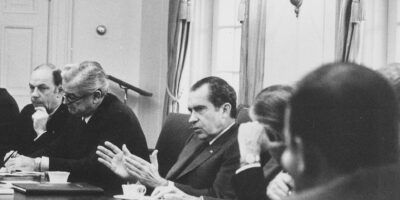Fauci Was Duplicitous on the AIDS Epidemic Too

In May 1983, amid the rapidly escalating AIDS crisis, a doctor at the National Institutes of Health (NIH) promoted a stunning theory about the newly encountered disease in the Journal of the American Medical Association (JAMA). Noting that the same issue of the journal contained an article documenting one of the first cases of the immunodeficiency disease’s appearance in an infant, the author sounded an alarm about “the possibility that routine close contact, as within a family household, can spread the disease.”
The article took an increasingly speculative turn in promoting this new theory. “If indeed the latter is true, then AIDS takes on an entirely new dimension,” it continued. “If we add to this possibility that nonsexual, non-blood-borne transmission is possible, the scope of the syndrome may be enormous.” Although the article reiterated the need to “be cautious” in accepting these findings as they awaited more evidence, the discovery “should at least alert us to the possibility that we are truly dealing with AIDS in children,” as transmitted through routine interaction.
The author of the article has since attained widespread familiarity. It was Dr. Anthony S. Fauci, a rising star within the NIH bureaucracy.
Press accounts, noticing Fauci’s article, immediately sounded the alarm. “Household contacts can transmit AIDS,” read one nationally syndicated report on the UPI wire dated May 5, 1983. The Associated Press queried the next day “Does AIDS spread by Routine Contact?” and quoted Fauci as their lead authority. The New York Times raised the specter of household transmission between family members, invoking Fauci’s commentary as its main authority.
We now know of course that Fauci’s theory was wrong. HIV, the virus that was later discovered to cause AIDS, only transmits by exposure to infected bodily fluids such as blood, or by sexual contact. The infant infection discussed in the same JAMA issue involved vertical transmission from the mother to child during pregnancy.
The damage was already done though, as the media went to work stoking alarm about AIDS transmission through simple routine contacts. Hundreds of newspapers disseminated the distressing theory from Fauci’s article. Writing a few weeks later, conservative columnist Pat Buchanan enlisted Fauci as the centerpiece of a rebuttal against Health and Human Services Secretary Margaret Heckler, who told him “there is no evidence…that the general population is threatened by [AIDS].”
On July 14, both Buchanan’s column and its excerpt of Fauci’s article were entered into the congressional record along with moralizing commentary that assigned blame for the disease to homosexual establishments and gatherings. Unfounded fears of transmission risk through simple contact, and accompanying social ostracization of the disease’s victims, became one of the most notorious and harmful missteps of the entire AIDS crisis.
It might be tempting to chalk Fauci’s error up to the scientific uncertainties of a novel disease. Medicine advances by investigating all plausible theories, subjecting them to testing, and ruling out those that lack evidence. In this case however, the more likely candidate was scientific negligence and unwarranted alarmist speculation.
Journalist Randy Shilts documented the incident in his classic early history of the AIDS crisis, And the Band Played On. Immunologist Arye Rubinstein had already offered a more plausible explanation for the infant case, which even cursory examination would verify: the disease transmitted from the mother to the baby during pregnancy. As Shilts explains, “Upon investigation, Rubinstein learned that Anthony Fauci had not bothered to read his paper.” The NIH scientist instead relied on second-hand information from another researcher to indulge in open-ended speculation (for a longer excerpt of Shilts, see David Henderson’s post on Fauci’s early career).
Although his speculative commentary had triggered a national media frenzy over unfounded fears of AIDS transmission through routine contact, Fauci himself emerged relatively unscathed from the episode. He did so by deploying an all-too-familiar tactic from his Covid-19 commentary: the political pivot, executed in front of a fawning news media.
On June 26, less than two months after his JAMA article appeared, Fauci publicly contradicted its most irresponsible claim – albeit without ever acknowledging his own central role in promoting that claim to begin with. As he told the Baltimore Sun, “It is absolutely preposterous to suggest that AIDS can be contracted through normal social contact like being in the same room with someone or sitting on a bus with them. The poor gays have received a very raw deal on this.” In short, Fauci flip-flopped with the political winds and the press barely even noticed.
It’s a familiar pattern to anyone who has closely followed the infectious disease bureaucrat’s public commentary since Covid-19 burst into the national news cycle last January. It usually starts with Anthony Fauci fielding a question about a disease from the press, at which point he offers up a highly speculative answer that nonetheless appears to carry the gravity of his own authority.
Fauci usually caveats his remarks with a stream of noncommittal auxiliary verbs – the disease “could,” “might,” or “may” behave as his latest prognostication asserts. But the press runs with a bold headline anyway, declaring that Fauci has spoken and his word is final…at least until it is not. That’s when Fauci modifies his prior position without even the slightest scrutiny from an adoring press corps, and proceeds as if his newer pronouncement has been his position all along. The flip-flop is then complete and broadcast by the same press as the new gospel, even if it directly contradicts the fair doctor’s own advice given only weeks or days prior.
Consider one of the first examples of Fauci’s commentary on Covid-19, given to CNN on January 24, 2020 – the day after the Wuhan region of China went into draconian lockdown. Asked about the Chinese government’s decision, Fauci declared “That’s something that I don’t think we could possibly do in the United States, I can’t imagine shutting down New York or Los Angeles.”
This assessment was no casual political preference, but rather reflected Fauci’s own judgment from past pandemics. He continued: “[h]istorically when you shut things down it doesn’t have a major effect.” Indeed, this was Fauci’s own position during the 2014 Ebola outbreak. A recently resurfaced interview on NBC shows Fauci warning against “draconian” quarantine measures for Ebola, and chastising several state governors for enacting hasty emergency restrictions to contain an outbreak in the United States without considering the unintended consequences.
By mid-March 2020, less than two months after he disavowed the use of lockdowns in major US cities such as New York and Los Angeles, Fauci executed a flip-flop and repositioned himself as the U.S. government’s primary architect of our historically unprecedented lockdown response. “If you look at the curves of outbreaks, they go big peaks, and then come down. What we need to do is flatten that down,” he told the press on March 11. On March 16, Fauci, along with the rest of the Trump administration’s coronavirus task force, threw their weight behind the now-discredited Imperial College Model of Neil Ferguson, igniting a wave of draconian shelter-in-place ordinances in not only New York and Los Angeles but ultimately 43 of 50 states.
“But the evidence on lockdowns changed!” comes the predictable cry of those who instinctively defend Fauci through every twist and turn in his messaging. Except it didn’t. Prior to March 2020, a substantial body of epidemiological literature strongly condemned lockdowns – both for their ineffectiveness and their extremely high social and economic costs. The only change that happened between January and March was political; namely that technocratic modelers such as Ferguson realized that fear and alarm over the coronavirus could be used to brush aside civil liberties and democratic norms in favor of a society-wide quarantine modeled on the Chinese response in Wuhan. Neil Ferguson openly boasted as much in a December 2020 interview, recalling the political sea change of those confused and panicked days from the previous March.
Among those who embraced this rapid political shift toward lockdowns was none other than Fauci. Indeed on February 17, 2020 the infectious disease administrator told USA Today that the risk from the coronavirus in the United States was “just minuscule.” Barely three weeks later Fauci would call for a nationwide lockdown, albeit for only two weeks.
For Fauci, that quickly became a month. Then two months. Then denunciations of states that reopened “too early.” Then testimony praising New York for remaining closed and providing a “model” Covid response despite boasting one of the highest per-capita death rates in the entire world. Then a push to reimpose stricter lockdowns in the fall. Per his latest prognostication, offered almost exactly 1 year to the day after he dismissed Covid-19 as a “minuscule” threat to the United States, we may return to normal by early 2022. And just like that, “two weeks to flatten the curve” became two years.
In recounting this history, it is important to be mindful that high-uncertainty events such as a novel virus and pandemic are unavoidably difficult to predict. But that acknowledged challenge is no excuse for figures like Fauci, who not only offer their prognostications on the whim of the moment but often do so on an entirely speculative basis, fully knowing that it will see credulous repetition in the press as an authoritative pronouncement.
Fauci’s greater fault is not that he errs, although he does err frequently, but rather the hubris of the moment through which he speaks even as he curiously shelters his pronouncements in caveats intended to permit a future pivot. Yet when that pivot occurs and Fauci adopts a completely different or even contradictory position in light of new political circumstances, he advances it with further hubristic pretensions before an obsequious gaggle of journalists, as if the new stance had always been his position.
We’ve now seen such pivots on countless occasions, including some that entailed willful duplicity. Consider Fauci’s pronouncements against mask wearing in March 2020 on 60 Minutes. By July, Fauci had not only reversed to the opposite position – he essentially conceded that he deceived the public back in March in order to allegedly prevent a run on masks that might cause a hospital shortage.
In effect, Fauci told what he considered to be a “noble lie” in the name of coaxing the public into a position he desired them to follow, rather than serving as a reliable source of scientific information. It’s a pattern he has repeated many times, most recently when he moved the target vaccination rate goalposts from 70% to 90% in a self-admitted deception intended to “nudge” the public toward his new position. That duplicity earned him praise though when he excused it as an effort to counter vaccine misinformation.
Even beyond these intentional manipulations though, Fauci’s commentary displays a stunning level of inconsistency and contradiction. Long after masking supplanted his initial advice against masking, Fauci shifted yet again to double-masking, then backtracked on this advice a few days later, then re-embraced the practice a few days after that in conjunction with a new CDC recommendation. More recently, he’s taken to contradicting himself on whether to expect the sharp peaks and declines in case numbers we’ve recently seen in the US and around the world. Yet throughout, Fauci’s reputation as a steady and measured source of sage wisdom and medical authority remains largely intact before the public’s eye.
Why? I’ll posit that it’s the product of a skilled political operative with four decades of honing his abilities to execute politically motivated pivots amid disease uncertainty.
Note the recurring characteristics of his public communications that have become hallmarks of Fauci’s style. Whether it’s the coronavirus of 2020-21 or the AIDS crisis of 1983, he routinely stakes out public positions that rely upon unwarranted speculation about scientific matters in the absence of evidence. His scientific statements carry an air of authority, and are certainly repeated as such by an adoring press – including in ways that mislead the public and even cause harm to our ability to address and combat an emerging disease. Yet if one reads his statements carefully, they also contain enough weasel words – “might,” “may,” “could” – to facilitate a convenient political pivot at a later date, shirking all responsibility for the harm caused in the process. And in the instances where a complete contradiction occurs, he takes refuge in duplicity for a “noble” purpose, which the press is all too happy to excuse away.
But missteps by powerful and trusted public health officials often lead to genuine harms. Indeed, it’s no small irony that Fauci’s initial response to AIDS triggered a wave of panicked fear that quickly morphed into the social ostracization of the disease’s victims. It’s not difficult to see similar patterns at play in the rise of a moralizing coronajustice ideology that treats all of society as a potential disease vector, and even valorizes social derision of those who contract Covid-19. While Fauci is not the only factor in the politicization of either disease, his vacillating commentary has often served to inflame these and other social ills, and usually with few or no professional repercussions to himself. Quite the opposite – the more he’s been wrong, the higher his stature has grown. The more he’s played politics in the name of doing science, the higher levels of political power he has attained.
If you want to see an end to the lockdown madness, the ongoing destruction of human lives and livelihoods, and the unprecedented government failures that have come to characterize our daily routines for the last year, the lessons of this administrator’s performance should be obvious. It’s time to stop listening to Fauci, and time to stop treating his wildly inconsistent political posturing as if it carries any scientific authority.










